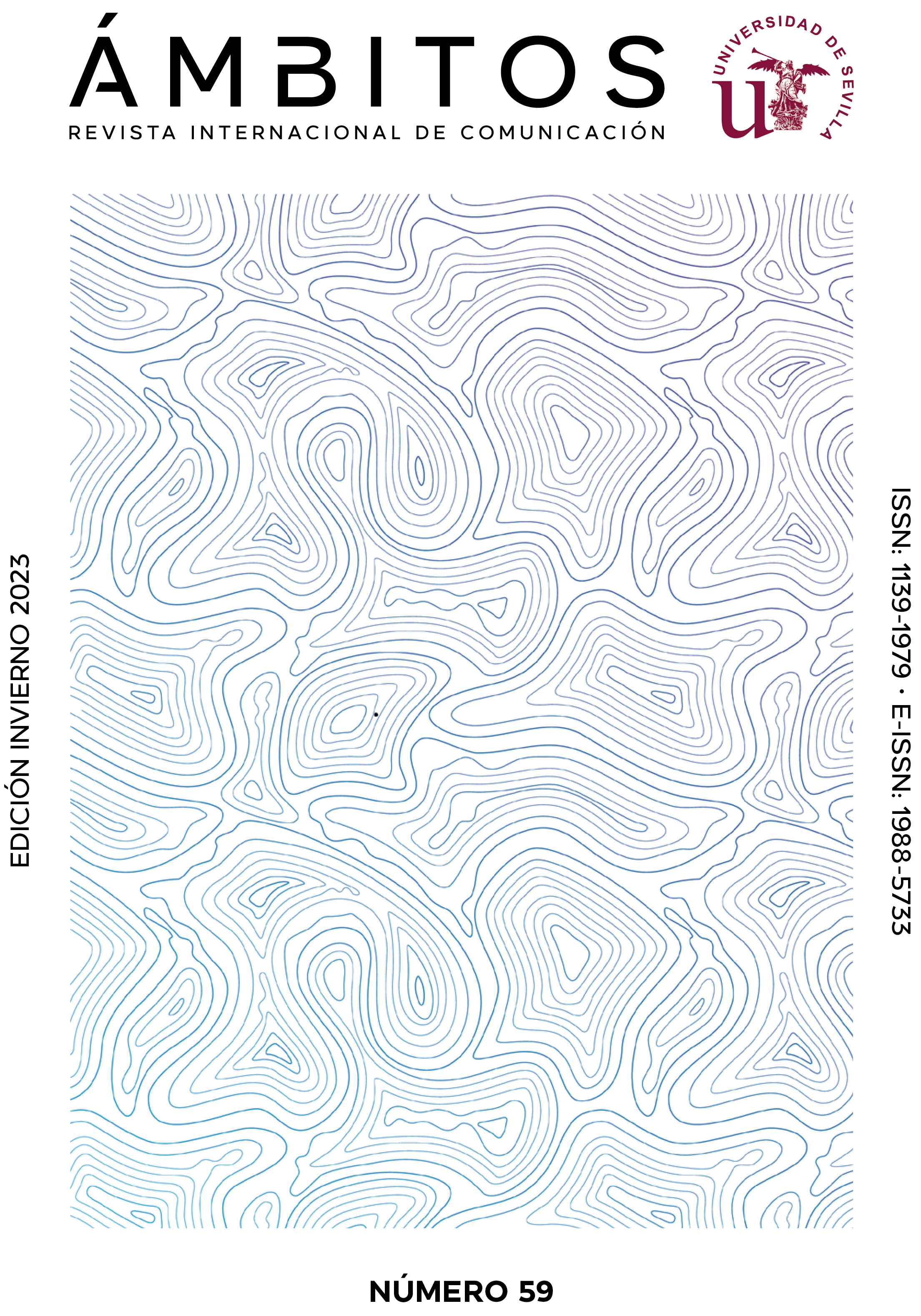Netflix’s Maid and representations of masculinities through social class: a textual analysis
DOI:
https://doi.org/10.12795/Ambitos.2023.i59.05Palabras clave:
Maid, masculinities, social class, textual analysis, hegemonyResumen
Netflix’s Maid chronicles the struggles of a heterosexual White single mother living in the Pacific Northwest of the United States. Using the concept of hegemonic masculinities and qualitative textual analysis, this study examined the 10 episodes of the limited series Maid to document the social construction of working-class and middle-class masculinities. Sean’s dysfunctional working-class life of six packs of beer and a single-wide trailer are juxtaposed against Nate’s offer of tidy suburban middle-class comfort and safety. I argue the program reifies stereotypical portrayals of working-class and middle-class men based on their homes, jobs, family background, leisure activities, and use of alcohol and drugs. Sean does not respect Alex’s bodily autonomy, her need for financial independence, or her need for freedom from emotional abuse. Similarly, Nate is unable to see past his entitlement toward Alex based on the material benefits he offers her like a reliable loaner vehicle, a clean two-story home, and pony rides for her daughter. I contend that Alex, the main protagonist, contests hegemonic masculinities to create her own space in the world without limitations dictated by the men in her life. Documenting how Maid tells the story of a woman and her romantic partners oppressed by hegemonic masculinities can provide insight into commonsense notions of romantic partnerships in the United States today.
Descargas
Citas
Beynon, J. (2004). The commercialization of masculinities: From the ‘new man’ to the ‘new lad.’ In: C. Carter & L. Steiner (Eds.), Critical readings: Media and gender (pp. 198-217). Open University Press.
Butsch, R. (1992). Class and gender in four decades of television situation comedy: Plus ça change… Critical Studies in Mass Communication, 9(4), 387-399.
https://doi.org/10.1080/15295039209366841
Butsch, R. (2011). Ralph, Fred, Archie, Homer, and the King of Queens: Why television keeps re-creating the male working-class buffoon. In G. Dines & J. M. Humez (Eds.), Gender, race, and class in media: A critical reader (3rd ed., pp. 101-110). Sage.
Connell, R. (2016). Masculinities in global perspective: Hegemony, contestation, and changing structures of power. Theor Soc, 45, 303-318.
https://doi.org/10.1007/s11186-016-9275-x
Connell, R. & Messerschmidt, J. W. (2005). Hegemonic masculinity: Rethinking the concept. Gender & Society, 19(6), 829-859.
https://doi.org/10.1177/0891243205278639
Dow, B. J. (1990). Hegemony, feminist criticism, and The Mary Tyler Moore Show. Critical Studies in Mass Communication, 7(3), 261-274.
https://doi.org/10.1080/15295039009360178
Dow, B. J. (1992). Femininity and feminism in Murphy Brown. Southern Communication Journal, 57(2), 143-155.
https://doi.org/10.1080/10417949209372860
Kaplan, D., Rosenmann, A. & Shuhendler, S. (2017). What about nontraditional masculinities? Toward a quantitative model of therapeutic new masculinity ideology. Men and Masculinities, 20(4), 393-426. https://doi.org/10.1177/1097184X16634797
Katz, J. (2011). Advertising and the construction of violent White masculinity: From BMWs to Bud Light. In: G. Dines & J. M. Humez (Eds.), Gender, race, and class in media: A critical reader (3rd ed., pp. 261-269). Sage.
Land, S. (2019). Maid: Hard work, low pay, and a mother’s will to survive. Hachette Books.
McKee, A. (2003). Textual analysis: A beginner’s guide. Sage.
Mastrocola, D. (2017). Performing class: Gilmore Girls and a classless neoliberal ‘middle class.’ Studies in Popular Culture, 39(2), 1-22. http://www.jstor.org/stable/44779928
Messerschmidt, J. W. (2018). Hegemonic masculinity: Formulation, reformation, and amplification. Rowman & Littlefield.
Morgan, D. (2004). Class and masculinity, In M. S. Kimmel, J. Hearn, & R. W. Connell (Eds.), Handbook of studies on men and masculinities (pp. 165-177). Sage.
Newitz, A. (1997). White savagery and humiliation: A new racial consciousness in the media. In M. Wray & A. Newitz (Eds.), White trash: Race and class in America (pp. 131-154). Routledge.
Otterson, J. (2022, February 14). ‘Maid’ creator Molly Smith Metzler inks Netflix overall deal. Variety.
https://bit.ly/3FAn9UO
Painter, C. & Ferrucci, P. (2019). Taking the white gloves off: The portrayal of female journalists on Good Girls Revolt. Journal of Magazine Media, 19(2), 50-71.
https://www.muse.jhu.edu/article/741602
Sheehan, S. T. (2010). «Pow! Right in the Kisser»: Ralph Kramden, Jackie Gleason, and the emergence of the frustrated working-class man. The Journal of Popular Culture, 43(3), 564-582.
https://doi.org/10.1111/j.1540-5931.2010.00758.x
U. S. Department of Justice. (2011, October). National survey of children’s exposure to violence.
https://www.ojp.gov/pdffiles1/ojjdp/232272.pdf
Descargas
Publicado
Cómo citar
Número
Sección
Licencia
Derechos de autor 2023 Melissa Boehm

Esta obra está bajo una licencia internacional Creative Commons Atribución-NoComercial-CompartirIgual 4.0.
Ámbitos. Revista Internacional de Comunicación es una revista de acceso abierto, lo que significa que todo su contenido está disponible gratuitamente para el usuario o su institución. Los usuarios pueden leer, descargar, copiar, distribuir, imprimir, buscar o enlazar con el texto completo de los artículos, o utilizarlos para cualquier otro fin lícito, sin solicitar permiso previo al editor o al autor. Esta definición de acceso abierto se ajusta a la Iniciativa de Acceso Abierto de Budapest (BOAI).

A menos que se indique lo contrario, todo el contenido de la edición electrónica se distribuye bajo una " licencia internacional Creative Commons Attribution-NonCommercial-ShareAlike 4.0 ". Puede consultar la versión informativa y el texto legal de la licencia aquí. Esto debe indicarse expresamente de esta manera cuando sea necesario.
En caso de aceptación del manuscrito, los autores ceden los derechos de la obra para su publicación a Ámbitos. Revista Internacional de Comunicación bajo el contrato de licencia Reconocimiento-NoComercial-CompartirIgual 4.0 Internacional (CC BY-NC-SA 4.0). Los autores conservan los derechos de autor y terceros están autorizados a copiar, distribuir y hacer uso de la obra, siempre que cumplan con los términos y condiciones establecidos en la licencia.
- Citar la autoría y la fuente original de publicación (revista, editorial y URL de la obra).
- No los utilice con fines comerciales.
- Si remezcla, transforma o crea a partir del material, debe publicar sus contribuciones bajo la misma licencia que el original.
Se puede encontrar más información en https://creativecommons.org/licenses/by-nc-sa/4.0/deed.es



















